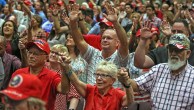
In an exclusive interview, Joe Lenski, co-founder and Executive Vice President of Edison Media Research discusses his organization’s plans for conducting exit polls on November 4, given this year’s special challenges including expected high voter turnout and unprecedented levels of pre-election day voting. Lenski is an expert in the operation and organization of survey research and has been involved in every major exit poll conducted in the last decade for the television networks and the Associated Press. Under his supervision, in partnership with Mitofsky International, Edison Media Research currently conducts all exit polls and election projections for the six major news organizations — ABC, CBS, CNN, Fox, NBC and the Associated Press that participate in the National Election Pool (NEP).
Interviewer: Andrew Kohut, President, Pew Research Center
Minor editing has been done on this transcript to improve clarity.
How many states are you going to cover this year?
We’re covering all of them. The news organizations historically cover every state in a presidential year. There will be a national survey, and there will be state surveys in all 50 states and the District of Columbia — with one asterisk on that. In three states, Colorado, Oregon and Washington, because of the sheer amount of early voting — and in Oregon and Washington’s case no voting on Election Day — we’re just doing a telephone poll. No actual exit polling in those three states.
I’m going to come back to that in some detail later. In the places where you’re doing precinct surveys, traditional exit polls, how many precincts are you surveying?
We’re doing over 1,300 precincts nationwide including 50 precincts in the most competitive states. Less competitive, smaller states will have proportionately fewer precincts.
Overall, what is the biggest challenge that you face this year?
Early voting is a big challenge because it has increased so dramatically. The other challenge is being prepared for the unexpected. We know there is going to be an increase in turnout we just don’t how much increase there is going to be. We know people who haven’t voted before are going to be voting. We’re more fortunate in that once we pick our polling places we just interview the people that show up there — we don’t have to do any modeling to account for turnout because we only talk to the people that turn out. But we have to check to assure ourselves that the differences in turnout we measure are not just noise but true increases.
What is your estimate of early voting?
Looking at the early voting statistics that state boards of election and secretaries of state are putting out, we have come out with a preliminary estimate of 28% this year.
Good, Pew has it 31%.
And Gallup is at 32% and CNN is at 29%. So at 28% we’re probably a little low; 30% is a good estimate for now.
In Washington state, Oregon and Colorado you’re only going to do phone surveys. How are you going to pick-up early voting in other states?
In the national survey, and in 15 other state surveys, we’re doing telephone interviews the week before the election of people who have already voted or are telling us they are definitely going to vote before Election Day. We started over the weekend and we’ll do it through this coming weekend.
Are you going to release the results of your national survey before the election?
No, nothing is released until after the quarantine for exit polling.
Will you use your national poll to do weighting of your exit polls? Will it give you some sense that your exit polls are in range?
We only use telephone polling to account for the missing data in the exit poll, the proportion of the electorate that is voting early. Ultimately, the two data sets are merged and weighted so that the early voter portion represents what we estimate it to be.
So you’re going to have to estimate what percentage the early vote will be for 47 states?
Correct. That’s why we plug into every secretary of state’s website, every board of election website. Mike McDonald, an expert on turnout and early voting, will be with us on Election Day.
Did you do this last time?
Yes. But there seems to be more information available this time. States like North Carolina and Georgia run these early voter statistics every day straight off their voter registration roles. You get detailed and up-to-date numbers in terms of percent male/female, age and race of early voters. We used that in the North Carolina primary to weight our early voter survey.
Are you calling cell phones?
Not on the telephone surveys.. But we are asking a cell phone-only question on the exit poll. So we will be able to see among the Election Day voters whether there is a difference. And we can take that into account on the early voter survey. We’re not going to be blind because we are asking a cell phone only question on the exit poll.
In regard to the problems associated with the 2004 exit polls, your report put great emphasis on interviewer training and the need for older interviewers. How are you doing on that task?
We’re doing very well. In 2006, and during the 2008 primaries, the average age of interviewer was 42 or 43-years-old, compared to 34-years-old in 2004. So what we put in place in terms of hiring and recruiting has worked.
How many interviewers are you going to employ?
We’ll have over 1,300 primary interviews. We’ll have several hundred backup interviewers and supervisors. In addition to that we’ll have 2,000 vote-count reporters, those who go to polling places to get actual returns. We’ll end up hiring over 3,000 people for one day’s work.
How are you dealing with the Democratic bias in the exit polls that occurred four years ago?
We have provided news organizations that subscribe to the exit polls with a lot of historical evidence on exit polling. Unfortunately, the non-response bias is not always consistent, whether state-by-state or election-to-election. So you cannot look at 2004 and predict what will happen in 2008. Each election is different. But, we have provided news organizations with historical information and more information about the interviewers and the precincts where they will be interviewing so they can do their own analysis on Election Day with regard to bias. A lot of information is flowing through the system. What news organizations are looking for is more information so they can be more or less confident about what they are seeing.
Some analysis showed a 2- or 3-point overstatement for Obama in the early reports of exit polls during the primaries. What are your concerns there?
There are a few patterns we’ve seen over the years that we’re keeping an eye on. One, higher-educated voters are more likely to fill out an exit poll than are lesser-educated voters. In an election where higher-educated voters are voting differently than lesser-educated voters you need to look at that. This may be part of the play here, as Obama, in the primaries and in pre-election polling, seems to be doing better among higher-educated voters. The other issue, historically, is when we’ve seen overstatements in exit polling — mainly 1992 and 2004 — they tend to coincide with elections where one partisan group is more enthusiastic about their candidate and the election. That’s not just true in the United States. In England, in 1992, they had an overestimate in the Labor Party vote, and their after-election analysis found that those who donated money or made phone calls were more likely to fill out a survey than those who were less active in a campaign.
Are you expecting a higher completion rate among younger people than older people?
Historically that has been true but that’s one thing we can adjust for. Our interviewers record the approximate age as well as gender and race of those who decline to take the survey. With regard to age, we don’t do this precisely. Interviewers assign respondents to one of three groups: 18 to 29, 30 to 59 and 60-plus. We find that interviewers can put people in the right age group about 95% of the time. In regard to race, we just record refusals by black and non-black.
When will news organizations get exit-poll data?
At 5 p.m.EDT the data are distributed to the news organizations. All of the subscribers work under the agreement that they will not release or publish any exit-poll data that will characterize the outcome of any race until all polls in that state have closed.
At what point in the evening will news organizations have a good idea how the race is going?
By about 8 or 9 p.m. we will have seen enough actual vote returns at the precinct level to be able to adjust for the non-response bias in several states.
Well, my hat is off to you, Joe, for your tenacity and rigor. And best of luck next Tuesday!
In an interview with Joe Lenski in December 2007, he and Andrew Kohut discussed the special problems in conducting exit polls in the then-coming campaign season given the unprecedented clustering of primaries and caucuses in the early months of 2008.
